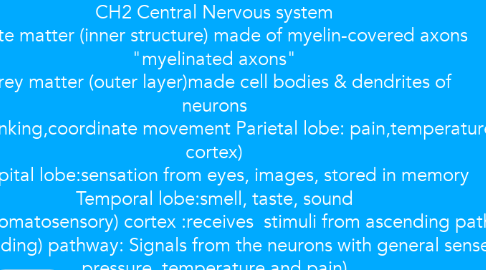
1. 1.Hippocampus
1.1. formation new memory & spatial orientation Damage-> 1. Alzheimer’s disease (neurodegenerative disorder)->impairment in memory, judgment, decision making 2. Parkinson's Disease : stiffness in one limb/ fine trembling of one hand when at rest. movements slow down, stiffer muscles
2. Cerebrum(the largest part) Functional part: cerebral cortex •Gray matter •Contains cell bodies of neurons •Deep folds and wrinkles increase the surface area
2.1. TWO halves: communicate through thick tract of nerves (corpus callosum)(connective tissue)
2.1.1. Messages handled -Lateralization of brain function
2.2. cerebral cortex: Located in telencephalon of forebrain Convoluted layer of cerebrum that contains gray matter
3. Limbic System
3.1. 2.Amygdala
3.2. 3.Thalamus
3.2.1. “relay” station for the ascending pathway to reach the cerebral cortex
3.2.2. Receives sensory signals processes signals & sends them to correct locations of the cerebral cortex
3.3. 4.Hypothalamus
4. Brainstem
5. Spinal Cord
5.1. Spinal Cord Functions (Central Nervous System) • Conduction – Information up and down body • Locomotion – Central pattern generators • Reflexes – Involuntary stereotyped responses Protected by the vertebra
5.2. Receives sensory signal & integrate signals (without assistance from the brain) •Generates involuntary motor signals to tissues or organs (i.e. reflex) The spinal cord acts as a tract, carrying sensory signals from PNS to brain & conscious (voluntary) motor signals from the brain to the PNS Vertebrae and meninges protect the spinal cord
5.3. The spinal cord contains •gray and white matters Spinal nerves contains roots, trunks, branches •Ventral and dorsal roots from corresponding horns & join to from a nerve trunk
5.3.1. Dorsal Horn and Ventral Horn Transmitting electrical impulses • via sensory pathways from the dorsal root into the dorsal horn of the spinal cord – the cell body of the neuron is at the dorsal root ganglion • extending motor pathways beyond the ventral horn – the motor signals to the target organs via the ventral root
5.3.1.1. Disease: Varicella Zoster Virus and Shingles -After a person recovers from chickenpox, the virus stays inactive in the body (dorsal root ganglion).
6. Brainstem
6.1. Structures: •Mid brain •Pons •Medulla oblongata
6.2. for breathing, swallowing, heart &smooth muscles activities
6.3. Reticular activating system (RAS) •Network of hyper-excitable neurons extending from brainstem through cerebral cortex •filters and routes information to appropriate location of the brain
7. Glial cells -constitute most of the volume of the nervous system •Provide supportive, protective & housekeeping functions
7.1. 1. Astrocytes • Stimulate formation of blood-brain barrier • Nourish neurons & secrete growth stimulants
7.2. 2. Oligodendrocytes • Form myelin sheaths髓鞘 surrounding the axons in brain & spinal cord
7.2.1. Disease: Multiple Sclerosis affects brain, spinal cord & optic nerves in eyes->problems related to vision, balance, muscle control
7.3. 3. Microglia • Macrophages in brain • Phagocytize and destroy microorganisms, foreign matter and dead nervous tissues
7.4. 4. Ependymal cells • Secrete and circulate cerebrospinal fluid
8. Electroencephalogram (EEG) Recording electrical potential->reflects brain (cerebral cortex) activity
8.1. Beta : alert Alpha: awake Theta: light sleep Delta: deep sleep
8.2. Non-Rapid Eye Movement (REM) sleep • 4 stages NREM stage 1: theta appears NREM stage 2: sleep spindle and K-complex NREM stage 3: delta NREM stage 4: delta
9. Cerebellum
9.1. •For movement, balance and hand-eye coordination •Receives sensory information
10. Projection pathways for Pain • May pass through the reticular formation • Signals may then go to hypothalamus and limbic system • Trigger emotional response
11. How to protect
11.1. Regulatory centers at Pons and Medulla •Skull: bone tissues •Meninges: 3 protective connective tissue layers •Cerebrospinal fluid: between meninges absorbs and disperse excessive mechanical forces •Blood-brain barrier
11.2. Meninges: “Protective Connective Tissues”
11.2.1. meninges of the CNS
11.2.2. 3 layers of connective tissue •protect the brain 1. Dura mater (outer layer) •adhering to the internal surface of the skull or vertebra •tough, white connective tissues 2. Arachnoid mater (middle layer) 3. Pia mater (inner layer)
11.3. Cerebrospinal Fluid (CSF)
11.3.1. •Produced by the choroid plexus
11.3.2. protects the CNS by •a cushion for brain structures •Reduces pressure on brain structures •Removes harmful substances •Transportis hormones to remote sites in the brain
11.4. Blood-Brain Barrier (BBB)
11.4.1. reduced permeability in capillaries->x potentially hazardous substances •Away from foreign substances •Away from hormones and neurotransmitters in the systemic circulation •Against drastic environmental fluctuations

